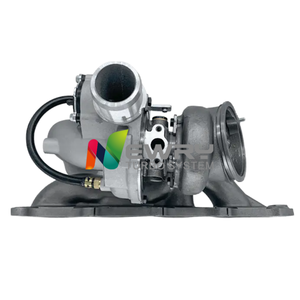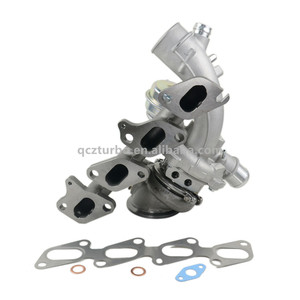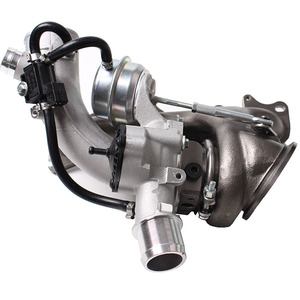(6679 products available)




















































































































































































Opel turbos are an important part of the vehicles made by the Opel company. They help the engines get more power without using a lot of gas. This is done by compressing the air going into the engine, so more of it enters. The extra air allows more fuel to burn in the engine, resulting in more power. The turbocharged engines come with lower displacement. The smaller engine burns less gas, but the turbo gives it more power when needed.
Turbos for Opels can be classified based on their design:
The ETC is a new type of turbo being developed but is not yet widely used. Each type of turbo has its own pros and cons depending on what is needed.
A new turbo for Opel can be a great addition to any vehicle, but it's important to know how to take care of it. Here are some specifications and maintenance tips for the turbo for Opel.
1. Turbo Size
The size of the new Opel turbo is based on the model. However, the sizes range from 0.5 to 2.0 liters. A larger turbo will generate more power, while a smaller turbo will be more fuel efficient.
2. Turbo Type
There are several types of turbos, including single, twin, and variable. Each type has its advantages and disadvantages. For example, a twin turbo will provide power across the entire RPM range.
3. Turbo Material
The materials used for the turbo are also important. Turbos are typically made from cast iron or stainless steel, which are both durable materials. However, cast iron turbos are better suited for high-temperature applications.
4. Turbo Design
The design of the turbo is also important. Turbos typically have a compressor wheel, turbine wheel, and housing. The design of these components will affect the performance of the turbo. For example, a larger compressor wheel will generate more boost, but it will also increase lag.
5. Boost Pressure
Boost pressure is the amount of pressure the turbo generates. Boost pressure is typically measured in pounds per square inch (PSI). Most Opels with a turbo have a boost pressure between 5 and 15 PSI. Higher boost pressure will result in more power, but it can also cause damage to the engine if it is not within the specified range.
1. Oil Changes
Regular oil changes are important for turbo maintenance. The oil keeps the turbo lubricated and cool. Be sure to use the recommended oil type and change it per the recommended schedule.
2. Air Filter
The air filter is important for turbo performance. A clean air filter ensures proper airflow to the turbo. Check the air filter regularly and replace it if dirty. A clogged air filter can restrict airflow and impact turbo performance.
3. Cool Down
Allowing the turbo to cool down before turning off the engine is important. Turbos run hot, and turning off the engine immediately can cause heat soak, damaging the turbo over time. After a long drive or heavy acceleration, let the engine idle for a few minutes to cool the turbo properly.
4. Exhaust Leaks
Check for exhaust leaks, as they can affect turbo performance. Even a small leak can impact boost levels and reduce power. Inspect the exhaust system regularly for leaks and repair them promptly.
5. Wastegate and BOV Maintenance
The wastegate and blow-off valve (BOV) play crucial roles in turbo management. Ensure they function correctly to regulate boost and release pressure. If experiencing boost fluctuations or abnormal turbo sounds, inspect these components.
Choosing a turbo for an Opel car is a big decision that can change how a car works. It is important to think carefully before making a choice. Here are some important things to consider:
Brand Reputation:
One should research and choose a well-known and trusted brand when selecting a turbo for Opel. Well-known brands are reliable and provide good support. They also give quality parts that work well.
Warranty and Support:
It is important to consider the warranty and support offered when selecting a turbocharger for an Opel vehicle. A good warranty protects the investment in case of problems. Reliable customer support is also important. If there are questions or issues, one needs help quickly. A strong warranty and helpful support give peace of mind and show confidence in the product.
Quality and Reliability:
Quality and reliability are important considerations when selecting a turbocharger for an Opel vehicle. High-quality components ensure consistent performance and durability, reducing the risk of failure. Reliable turbos provide stable power delivery and efficiency, enhancing the driving experience. Invest in quality and reliability to avoid problems and enjoy a smooth ride.
Compatibility and Fitment:
Compatibility and fitment are crucial when choosing a turbocharger for an Opel vehicle. Ensure the turbo is designed to work with the specific engine and exhaust system of the Opel model. A properly fitted turbo optimizes performance and avoids issues. Check connections, mounting points, and specifications to ensure the turbocharger will seamlessly integrate with the vehicle.
Performance Goals:
Before selecting a turbocharger for an Opel car, consider the performance goals. Decide how much power and torque the engine should have. Higher numbers mean the car goes faster, but they can also cause damage. Balance the desire for speed with the need for reliability. A well-chosen turbo can meet performance goals and keep the car working well for a long time.
Budget Considerations:
Budget considerations are important when choosing a turbo for an Opel vehicle. High-performance turbos can be expensive, but there are many options at different prices. In addition to the turbo's cost, consider expenses for installation, tuning, and supporting parts. Finding a turbo that fits the budget and meets performance needs is important. Research and plan carefully to get the best value for the money.
Fuel Requirements:
When selecting a turbo for an Opel vehicle, fuel requirements must be considered. Some turbos need higher-quality fuel for best performance. If the turbo requires fuel with a higher octane rating, make sure it is available and affordable. Using the right fuel is important for the turbo to work correctly and give optimal power. Check the fuel needs in the turbo specifications before making a choice.
Installation and Tuning:
When choosing a turbo for an Opel vehicle, consider installation and tuning. Some turbos are easier to put on than others. Decide if professional installation is needed or if it can be done at home. Also, think about tuning. Some turbos need tuning for best performance. Ensure one has the tools or plans to get the car tuned by an expert. Proper installation and tuning are important for the turbo to run smoothly and give great power.
Driving Style:
Driving style is an important factor when choosing a turbo for an Opel vehicle. Some turbos are designed for sporty driving with quick power delivery, while others are more fuel-efficient. Consider the driving habits, too. If one drives aggressively or prefers a balance of power and efficiency. Choose a turbo that matches the driving style and needs. A well-suited turbo improves the driving experience and makes every ride enjoyable.
Before attempting to replace the turbocharger, it's important to have the right tools and equipment for the job. This includes hand tools, a torque wrench, and potentially some specialized tools for working on the specific components of the turbo system.
Follow these steps to replace turbo for Opel models:
Preparation
Ensure the car is parked on a level surface. Allow the engine to cool down before starting any work. Disconnect the battery by removing the negative (-) terminal first, followed by the positive (+) terminal.
Accessing the Turbocharger
Open the hood and locate the turbocharger. It is usually situated near the exhaust manifold. Depending on the Opel model, some components may need to be removed to access the turbo. This could include the intake ductwork, heat shield, or exhaust downpipe.
Removing the Turbocharger
Start by disconnecting the wastegate actuator rod from the wastegate. Then, disconnect the oil feed and return lines to the turbo. Be prepared for some oil leakage. Next, disconnect the intercooler piping and electrical connections (if applicable) to the turbo. Finally, remove the turbo mounting bolts and carefully pry the turbocharger loose from the exhaust manifold. It may require some force, as it could be sealed with gasket material.
Installing the New Turbocharger
Clean the mounting surfaces on the exhaust manifold and ensure no old gasket material remains. Position the new turbocharger onto the exhaust manifold and carefully align it. Secure it with the mounting bolts, tightening them to the manufacturer's specified torque.
Reassembly
Reconnect the oil feed and return lines to the turbo, ensuring proper torque and using new gasket where necessary to prevent leaks. Reconnect the intercooler piping, electrical connections, and wastegate actuator rod. Reinstall any removed components, such as the exhaust downpipe, heat shield, and intake ductwork. Ensure all bolts and clamps are tightened securely.
Finishing Up
Reconnect the battery terminals, starting with the positive (+) and then the negative (-). Start the engine and let it idle for a few minutes. Check for any oil or coolant leaks around the turbo and its associated lines. Take the car for a short test drive and monitor performance. Recheck for any leaks or unusual noises after the drive.
Q1: How can I know if my turbo needs replacement?
A1: There are several signs to look out for that indicate a turbo replacement is needed. These include a significant drop in engine performance, increased exhaust smoke, oil leaks from the turbo, and a whining or rattling noise from the turbo when it is in operation.
Q2: What is the difference between a turbocharger and a supercharger?
A2: A supercharger draws power directly from the engine to compress the air in the cylinders. This usually results in a more powerful engine but at the expense of fuel efficiency. On the other hand, a turbo uses the energy from the exhaust gases that the engine produces to spin a turbine and compress the air.
Q3: What should be the interval for turbo maintenance checks?
A3: Regular turbo maintenance checks are essential for optimal vehicle performance and durability. For vehicles with standard turbo fitments, it is advisable to have maintenance checks after every 10,000 to 15,000 kilometers. However, for high-performance or modified turbos, it is recommended to have maintenance checks more frequently.
Q4: Can a turbo be fitted to any car?
A4: While it is technically possible to fit a turbo on any car, it is best to fit it on a car that has a naturally aspirated engine. This is because most modern cars come with factory-fitted turbo engines. Fitting a new turbo for opel on a car that already has a turbo may lead to compatibility issues and may require extensive modifications.